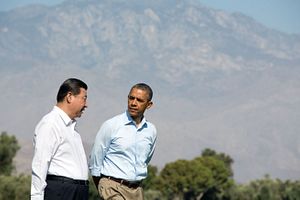The prominent realist international relations scholar John Mearsheimer says there is a greater possibility of the U.S. and China going to war in the future than there was of a Soviet-NATO general war during the Cold War.
Mearsheimer made the comments at a lunch hosted by the Center for the National Interest in Washington, DC on Monday. The lunch was held to discuss Mearsheimer’s recent article in The National Interest on U.S. foreign policy towards the Middle East. However, much of the conversation during the Q&A session focused on U.S. policy towards Asia amid China’s rise, a topic that Mearsheimer addresses in greater length in the updated edition of his classic treatise, The Tragedy of Great Power Politics, which is due out this April.
In contrast to the Middle East, which he characterizes as posing little threat to the United States, Mearsheimer said that the U.S. will face a tremendous challenge in Asia should China continue to rise economically. The University of Chicago professor said that in such a scenario it is inevitable that the U.S. and China will engage in an intense strategic competition, much like the Soviet-American rivalry during the Cold War.
While stressing that he didn’t believe a shooting war between the U.S. and China is inevitable, Mearsheimer said that he believes a U.S.-China Cold War will be much less stable than the previous American-Soviet one. His reasoning was based on geography and its interaction with nuclear weapons.
Specifically, the center of gravity of the U.S.-Soviet competition was the central European landmass. This created a rather stable situation as, according to Mearsheimer, anyone that war gamed a NATO-Warsaw conflict over Central Europe understood that it would quickly turn nuclear. This gave both sides a powerful incentive to avoid a general conflict in Central Europe as a nuclear war would make it very likely that both the U.S. and Soviet Union would be “vaporized.”
The U.S.-China strategic rivalry lacks this singular center of gravity. Instead, Mearsheimer identified four potential hotspots over which he believes the U.S. and China might find themselves at war: the Korean Peninsula, the Taiwan Strait and the South and East China Seas. Besides featuring more hotspots than the U.S.-Soviet conflict, Mearsheimer implied that he felt that decision-makers in Beijing and Washington might be more confident that they could engage in a shooting war over one of these areas without it escalating to the nuclear threshold.
For instance, he singled out the Sino-Japanese dispute over the Senkaku/Diaoyu Islands, of which he said there was a very real possibility that Japan and China could find themselves in a shooting war sometime in the next five years. Should a shooting war break out between China and Japan in the East China Sea, Mearsheimer said he believes the U.S. will have two options: first, to act as an umpire in trying to separate the two sides and return to the status quo ante; second, to enter the conflict on the side of Japan.
Mearsheimer said that he thinks it’s more likely the U.S. would opt for the second option because a failure to do so would weaken U.S. credibility in the eyes of its Asian allies. In particular, he believes that America trying to act as a mediator would badly undermine Japanese and South Korean policymakers’ faith in America’s extended deterrence. Since the U.S. does not want Japan or South Korea to build their own nuclear weapons, Washington would be hesitant to not come out decisively on the side of the Japanese in any war between Tokyo and Beijing.
Mearsheimer did add that the U.S. is in the early stages of dealing with a rising China, and the full threat would not materialize for at least another ten years. He also stressed that his arguments assumed that China will be able to maintain rapid economic growth. Were China’s growth rates to streamline or even turn negative, then the U.S. would remain the preponderant power in the world and actually see its relative power grow through 2050.
In characteristically blunt fashion, Mearsheimer said that he hopes that China’s economy falters or collapses, as this would eliminate a potentially immense security threat for the United States and its allies. Indeed, Mearsheimer said he was flabbergasted by Americans and people in allied states who profess wanting to see China continue to grow economically. He reminded the audience that at the peak of its power the Soviet Union possessed a much smaller GDP than the United States. Given that China has a population size over four times larger than America’s, should it reach a GDP per capita that is comparable to Taiwan or Hong Kong today, it will be a greater potential threat to the United States than anything America has previously dealt with.

































